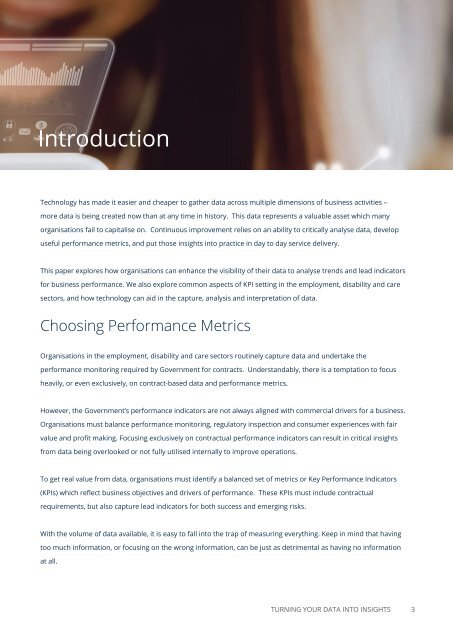Turning Your Data into Insights
Create successful ePaper yourself
Turn your PDF publications into a flip-book with our unique Google optimized e-Paper software.
Introduction<br />
Technology has made it easier and cheaper to gather data across multiple dimensions of business activities –<br />
more data is being created now than at any time in history. This data represents a valuable asset which many<br />
organisations fail to capitalise on. Continuous improvement relies on an ability to critically analyse data, develop<br />
useful performance metrics, and put those insights <strong>into</strong> practice in day to day service delivery.<br />
This paper explores how organisations can enhance the visibility of their data to analyse trends and lead indicators<br />
for business performance. We also explore common aspects of KPI setting in the employment, disability and care<br />
sectors, and how technology can aid in the capture, analysis and interpretation of data.<br />
Choosing Performance Metrics<br />
Organisations in the employment, disability and care sectors routinely capture data and undertake the<br />
performance monitoring required by Government for contracts. Understandably, there is a temptation to focus<br />
heavily, or even exclusively, on contract-based data and performance metrics.<br />
However, the Government’s performance indicators are not always aligned with commercial drivers for a business.<br />
Organisations must balance performance monitoring, regulatory inspection and consumer experiences with fair<br />
value and profit making. Focusing exclusively on contractual performance indicators can result in critical insights<br />
from data being overlooked or not fully utilised internally to improve operations.<br />
To get real value from data, organisations must identify a balanced set of metrics or Key Performance Indicators<br />
(KPIs) which reflect business objectives and drivers of performance. These KPIs must include contractual<br />
requirements, but also capture lead indicators for both success and emerging risks.<br />
With the volume of data available, it is easy to fall <strong>into</strong> the trap of measuring everything. Keep in mind that having<br />
too much information, or focusing on the wrong information, can be just as detrimental as having no information<br />
at all.<br />
TURNING YOUR DATA INTO INSIGHTS<br />
3
















